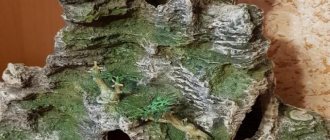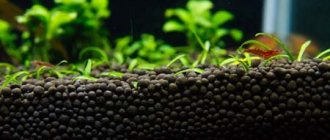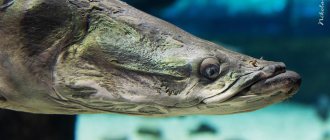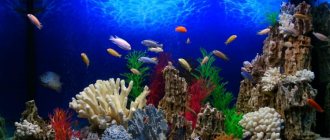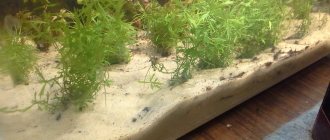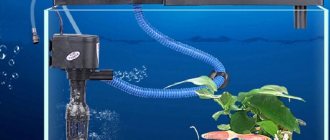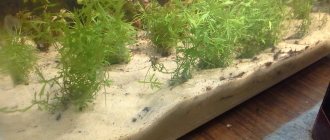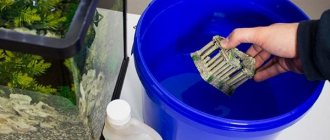Stones play a huge role in building an aquarium composition, and even more so in building a professional aquascape. Stones are the strength, power and monumentality of an aquarium composition! Who is who, and I, Father FanFishki, admire them. There are aquascapers who specialize more in weaving driftwood, for example, a Ukrainian colleague Teresa Lazar - it turns out great. We can say that she is a seamstress. Here are some of her winning and top works. Check it out
Teresa IAPLC 2018 – 12th place “Honour prize”
Teresa Lazar IAPLC 2021 TOP 45
To weave something like this you need patience, artistic talent and a couple of tubes of warming ointment for the tailbone =)
I, most likely because of my masculinity and love for the work of James Hetfield, like stones more. I see their harsh beauty and it delights me. I implement all my landscapes with the idea that stone hard is a partner, and plants are a partner. The partner is the foundation/monolith, he leads the partner. Plants, in turn, are a decoration for the partner; they envelop the harsh burrow of the stone. And only thanks to this union, what we call harmony is obtained.
To date, my passion for stones has been best realized in the Troll's Tongue .
“Troll Tongue” IAPLC 2021 RANGING 20 Honor Prize
“Troll Tongue” IAPLC 2021 RANGING 20 Honor Prize
In this article, I will try to give advice on choosing and working with stone. And at the end of the article, you will see where I started - with stones for the bath =). Which will emphasize one very important idea - nothing is given at once. But at the same time, it is important that you are bursting and excited about the aquarium and the very process of building a new aquarium composition. When this happens, any difficulties: financial, physical, time - fade into the background. Difficulties are accepted with pleasure. Anyway, let's get down to business.
What stones are used in aquarium keeping?
The answer is any. But since the article is aimed at herbal aquarium keeping, I would like to draw the attention of beginners to the fact that stones for herbalism should not hiss. This can be checked simply - drop some table vinegar on the stone, or better yet, a preparation from the pH/kH minus series and see if the stone hisses - it’s bad. No - good.
It is rare to find a completely non-sizzling stone. But nevertheless, it is important that there is no very strong hissing. The fact is that calcium inclusions increase water hardness. And as you know, it is advisable to keep good herbalists in a soft, slightly acidic environment with a pH/kH below 7. In this case, the plants will best absorb macro and micro elements. Read more about this here .
Marble, limestone, shell rock, Kenya stone and other cobblestones containing abundant calcium formations are not suitable for the herbalist. Their place in African cichlids .
Next, I will draw your attention to the individual properties of the stones. There are light stones and there are heavy ones. There are dense stones, and there are those that easily crumble.
In my latest works, I use a stone under the commercial name “Grey Mountain”, also often called Carpathian stone. So, despite all its beauty, it is heavy and very dense. This imposes certain difficulties when building a composition on the second, third... X-tier.
As a counterbalance to “Grey Mountain”, you can put lava stones - light, porous, crumble as you want. Or, for example, the pop stone “Dragon” also crumbles very well, and is many times easier than “Grey Mountain”.
Dragon Stone
Lava Stone
Understanding these simple nuances can seriously help you in working on your intended composition. Aquascape is Lego for adults, so the quantity and quality of parts is important. It is important that the details correspond to the idea - the task at hand.
Where to buy stones for an aquarium?
Currently, the zoo industry market offers us, aquarists, a large palette of stones for the aquarium. You can buy them at your local store or you can order them online. I would like to draw your attention to a wide range of stones under the Gloxy brand . Here are a few compositions with their participation.
Gloxy Stone “White Tiger”
Stone Gloxy “Relic” Ibn “Grey Mountain” =)
Gloxy Elephant Skin Stone
At the same time, stones can be found independently: in forests, mountains, on old volcanoes or near a rocky seashore.
For those who do not have the opportunity to walk through forests and fields + a pipe on a budget, we can advise you to go to a construction supermarket and take “Stones for a bath” (20 kg. 300-400 rubles) - gabrro diabase. Actually, a long time ago, I started with it. Here is my second, more or less composition on diabase . It turned out very nicely, especially considering that those were the times of a dashing and silly newcomer.
“Where the Red Dragon Lives” Layout 2000 Shaggy Year
Why are there stones in an aquarium?
Only novice aquascapers are sure that the stones in their ponds are intended solely for decorating the bottom.
They are partly right. Stones make the aquarium look like a natural pond. However, the functionality of stones in an aquarium is much wider:
- imitation of natural habitat for aquatic fauna;
- organization of spawning sites;
- regulation of biobalance;
- providing anchorages for plant roots.
When selecting options for decorating an aquarium, the size of the stones and the ratio of their sizes to the volume of the reservoir, as well as the nature of the vegetation, are taken into account:
- Large specimens, especially smooth boulders from the sea, cannot be used to grow Vallisneria.
- If potted plants are planted in the aquarium, they are surrounded by medium-sized stones. You can use them to create grottoes and caves, or cover them with driftwood.
- If floating vegetation is used, the size and shape of the stones can be any. The main thing is that they do not clutter the bottom too much.
Raid
One of the most common problems that arise is that the stones begin to turn green. You can get rid of this. Water and other surfaces often turn green or black. This indicates the appearance of algae. This is not a serious problem, but it is the first sign that the water in the aquarium is starting to bloom, so it is still advisable not to ignore it.
To remove green or black deposits, you just need to carefully monitor the aquarium. Don’t forget to do water changes, don’t add too much food to the fish, check that the filter is working properly and, most importantly, monitor the length of daylight hours. It should not be too large, because excess light is one of the main reasons for the appearance of algae. Special products purchased in the store can also help in getting rid of plaque. Before removing it, the plaque itself is cleaned with a scraper from all accessible places. But without caring for the aquarium, no matter how much you peel off, the algae will not just go away.
Beautiful stones for aquascaping
Each aquascape, no matter how integral and harmonious it may look, consists of individual elements. And stones play the main role here. They are the bright accent around which the entire composition is built. Therefore, stones for aquascape are selected especially carefully, primarily focusing on appearance.
The following stones look good in the water:
The Dragon
It is fossilized clay in origin. The peculiarity of the stone is the holes located with an orientation in one direction. This makes the Dragon look like a rock covered in dragon scales. Most often, this stone has a greenish-brown tint and is lighter in weight compared to other natural rocks.
Porphyry
A type of granite rock of volcanic origin. It has a characteristic structure that gives it its name. Crystals of gray quartz and fawn spar with shiny edges are visible on the smooth surface. Porphyry can be reddish, greenish, brown, or purple.
Cavernous sandstone
Blocks of various shapes and sizes with through holes. The rough surface of this stone is highly decorative. You can gouge out large holes in the stone and it will look like a grotto.
Gneiss
A breed of increased hardness. Its composition is identical to that of granite, but differs in appearance by pronounced striping. Usually the stripes are gray, less often white or gray-green.
Elephant (Elephant stone)
A stone with a very textured surface of gray or brownish color. It looks like the wrinkled skin of an elephant, which gives the stone its name.
Carpathian stone
One of the best options for creating natural style compositions. It has natural shades and practically does not affect water parameters.
Gray Mountain (Gray Mountain)
Its name speaks for itself. The texture and color of this stone imitates natural rocks. This option is indispensable for compositions in the Iwagumi style.
Gabbro diabase
A completely crystalline volcanic rock with a dark gray or greenish-black color. Looks good in glued compositions.
Slate
A hard rock with a layered structure. Color ranges from light gray to almost black. Brightly colored stripes are visible on the side faces.
Mesh stone
The porous structure is highly decorative and at the same time serves as a natural biofilter.
Samurai
A black stone of varying saturation with a porous surface.
A wide selection of stones and ready-made compositions for aquascapes is offered by a specialized manufacturer of equipment for aquariums, ADA. In online stores you can purchase both individual stones of interesting texture from this company (natural and artificial) and ready-made sets for aquascape.
Natural stones: pros and cons
Minerals taken from the natural environment have many benefits:
- cheap or even free material for decorations;
- variety of shapes and colors;
- look natural;
- easy to wash and clean;
- can be used to bring any composition into reality.
They have only one drawback: some rocks can change the hardness and acidity of the aquatic environment, sometimes to a critical level. This feature must be taken into account when arranging a home pond.
Sometimes natural stones are coated with dyes and glued together. If the work is done poorly, the composition will collapse and cause deterioration in the health of the fish. Below is a list of breeds commonly used by aquarists:
- Pebbles. Pebbles for an aquarium are a universal decor. Rocks that fall into bodies of water and are exposed to water for a long time acquire rounded shapes. They come in various sizes and colors, with veins and inclusions.
- Sandstone. Sedimentary rock that consists of sand and clay. Sandstone for an aquarium is not always a good decorative option, as it changes the hardness and acidity of the aquatic environment. In addition, some species are very fragile.
- Limestone. The basis of this mineral of sedimentary origin is calcium carbonate. Possible inclusions of magnesium salts and fossils. Has a solid or loose structure. Limestone increases the hardness and acidity of the aquatic environment and quickly becomes overgrown with algae.
- Granite. It is of volcanic origin. Does not release hazardous substances into water. A heavy multi-colored mineral with a mosaic of different colors. Often used by aquarists to build rock compositions. An aquarium with granite stones looks impressive.
- Gneiss. Slate is a type of solid rock that does not affect the water structure and composition. Pebbles with colored stripes can be safely used to create decor.
- Shell rock. The porous formation of compressed mollusk shells is easy to process to create an aquatic landscape. Shell rock is one of the most common rocks for decoration.
- Tuff . This porous rock is based on volcanic ash. Lightweight, durable, comes in a variety of colors. One of the rock varieties is calcareous tuff. A suitable material for arranging a home for fish that love an alkaline environment and many pitfalls.
- Quartzite. Small grains of quartz fused into one pebble. High strength, but at the same time it can be easily divided into parts. Quartz is found in pink and green shades.
- Gabbro-diabase. Stone of volcanic origin is one of the most durable and widespread in nature. Crushed stone is made from it and pavements are laid. The structure is compared to basalt. Does not emit harmful substances, suitable for creating underwater compositions.
- Jasper. A semi-precious solid opaque mineral that is not just a decoration, but also has special energy. The main component of jasper is quartz. It looks especially beautiful in red.
How to prepare rocks for immersion in an aquarium
Store-bought stones often attract novice aquascapers because they have already been tested and processed, and therefore do not require additional manipulations. Often, nice compositions have already been created from them, with which the aquarium will not be original, but is guaranteed to be beautiful.
But many aquarists do not understand why they should pay for material lying under their feet. However, you can't just collect cobblestones from the street and put them in water. With such actions, you risk introducing an infection into the ecosystem, which will then be very difficult to get rid of. Self-collected specimens must be checked for the release of harmful substances and specially disinfected.
“Fonit” or not “phonite” stone
It is important to first check any selected specimen for calcium carbonate content. In aquarist slang, it is necessary to check whether a cobblestone is “fouling.” Such stones will dissolve in water and increase its hardness. And this is very harmful for flora and fauna.
Most aquatic plants are sensitive to high water hardness. But there are exceptions: Madagascar aponogetons lattice, baivianus grow in waters with a hardness of 0.8-1.2dH, and die in aquariums at a hardness of 4-5dH. Cryptocoryne ciliate, on the contrary, grows at hardness levels exceeding 20-30dH.
Lime rocks can and even must be placed in aquariums that contain crabs, shrimp and snails. In soft water, their shells soften and lose their protective properties. Some types of fish are also lovers of hard water: American cichlids, Malawians, Tanganyikans, Victorians, swordtails, mollies and other representatives of poeciliids.
Calcium carbonate is harmful to all other representatives of flora and fauna. Therefore, we carry out tests with stones using hydrochloric, sulfuric or acetic acid. Draw the substance into a syringe and pour it over the selected stone. The bubbles released during this procedure indicate the content of calcium carbonate in the rock. If there are no bubbles, you can safely use the stone in an aquarium with soft water.
“Bath” procedures for stones
The next stage of preparation for diving is cleaning and disinfection.
These procedures consist of the following steps:
the washing up
To get rid of stubborn stains, soak the stones for a while. 30 - 49 minutes is enough. Then wash the surface under running water with a stiff brush, paying special attention to the grooves. You should not use cosmetics or household chemicals for washing, since it is not known what reaction their interaction with the material may cause.
Boiling
Experienced aquarists have different opinions on this issue. Some consider the procedure unnecessary. In their opinion, washing in hot water or dousing with boiling water is quite enough. Perfectionists advise boiling stones over low heat for 1 – 2 hours. Or bake in the oven at maximum temperature for 20 - 30 minutes.
Disinfection with chemical solutions
The method can be used if heat treatment is not possible. It is also better to use this treatment for stones with a porous structure, since they can be destroyed during boiling. The treatment is carried out with a solution of bleach and water in a ratio of 1:10. Fill the stones completely and leave for a day. Then immerse it in clean water for an hour. Additionally, rinse the stones with running water.
If you have boiled or calcined the stones, do not rush to put them in the cold water of a neglected aquarium. Cool them down so as not to cause a sudden temperature jump in the ecosystem.
Preliminary preparation
Once the pebbles have been selected and checked, the next task is to prepare them. Of course, the first thing you need to do is clean them. This is done with a stiff brush under running water. When cleaning, only water and a brush are used, since even a slight residue of household chemicals can affect the water balance in the aquarium.
Simple mechanical cleaning is not enough to place stones in water. In order to accurately get rid of bacteria and chemical residues, heat treatment will be required. Boiling will kill any bacteria that may still be in or on the surface of the stone. You can also use special store-bought products.
Don't forget about heat treatment
Heat treatment
At this stage, you will need a regular deep saucepan and running water. It is important that all stones are completely submerged under water. There is no need to add additional additives, as they still won’t do a better job than high temperature. To achieve the greatest effect, it is better to boil water over medium heat for 20-30 minutes.
After this, carefully remove the aquarium stones and leave them to dry on a paper towel. After heating for a long time, they will retain heat for a long time, so they need at least an hour to cool down. After cooling, the stones can be immersed in the aquarium.
Although boiling is a universal remedy, it is not suitable for porous rocks. As the temperature increases, they will begin to crumble and break as soon as the water begins to boil. Therefore, only store-bought products are usually used to disinfect porous rocks.
Follow heat treatment instructions
Using Cleaning Products
In cases where heat treatment is impossible for some reason, you can turn to special solutions for help . And although their effectiveness is slightly lower than boiling, they are able to cope with most harmful bacteria.
In order to effectively clean the pebbles, you will need a spacious and durable container. Volume is of great importance, since the solution must completely cover the stones. Each product has its own instructions for use, so for successful cleaning you just need to follow the instructions on the package. After the stones have been in the solution for a day, they will need to be carefully removed and washed thoroughly under running water.
How to post
- You can't just throw stones on the bottom . It is important to arrange them beautifully, creating a certain composition. Nature is diverse and natural, but this does not mean that there is no order in it. The construction of a stone skeleton is subject to certain rules of beauty and safety.
- One of the most common mistakes that beginners make when placing heavy decorations in an aquarium is placing them against the walls. Under strong pressure, the glass will crack. Most aquarium materials are durable, but can break easily under added pressure.
- Avoid placing rocks in one part of the aquarium . It's better to spread them out evenly. But if the intended design does not fit into the recommendations, then you need to make sure that the glass can withstand the additional weight.
- Ensure the durability of the composition . Otherwise, a fast school of fish may knock over a pebble, which, depending on its size and weight, may result in a crack in the glass. But even if the glass stands, the stone can crush one of the inhabitants of the aquarium. You can strengthen the composition with special aquarium silicone glue. Most pet stores offer safe products, but it doesn't hurt to double check.
As for style, there are several composition options:
Iwagumi
This Japanese style is preferred by aquascape guru Takeshi Amano in his compositions. It is based on the use of 1 – 2 large stones of outstanding height in the center of the composition, framed by several small specimens and one type of low-growing plants.
Hardscape
Translated, the word means Hard - hard, heavy and Scape - landscape. The design is characterized by heaviness and heaviness. The bottom is completely filled with heavy stones and driftwood. This design is preferable for cichlids.
Dutch style
Stones in this version serve as an imitation of garden paths. Therefore, small specimens are placed on the bottom. This herbal aquarium resembles a flowerbed.
Pseudo-natural style
Shell rock, large pebbles and granite will fit well into this composition. Natural stones in this version are combined with glass and plastic.
Natural style
A union of stone and wood, or rather oddly shaped driftwood. The designer's task is to recreate the appearance of a natural reservoir.
Don't turn your aquarium into a mineral museum. It is better if it contains specimens of the same texture and similar in color. Then at the bottom of the reservoir you will get a natural, harmonious composition.
Disadvantages of sandstone for an aquarium
Are there any disadvantages that need to be taken into account?
- It is not possible to use any variety of aquarium sandstone. It is assumed that there is a need to be aware of existing restrictions. Certain types of material are very soft and brittle, so they are not always suitable.
- Sandstone can lead to an increase in water hardness and acidity, so this material cannot be used for all fish. Despite this, a disadvantage can be an advantage. Some aquarium fish initially love hard water and note the maximum benefits for themselves, because they need such conditions for their lives. For example, hard water is required for Malawian cichlids.
The above shortcomings suggest the need to take into account additional factors for the successful use of aquarium sandstone.
DIY stone compositions
You can create a large, fancy composition, similar to those expensive options that we see in pet stores, with your own hands. To do this, you can use relatively small specimens and fasten them together by gluing. You can’t just stack stones on top of each other and fill them with water!
To glue stones and any other decor in the aquarium you will need:
Filters for cigarettes (can be purchased at a tobacconist).
Super glue is liquid (not gel).
Transparent silicone sealant.
Take the filter, gut it and place it between stones, glass and stone. Fill with glue. Everything hisses and smokes, but freezes in seconds.
This method allows you to fix the stones, but break them off quite easily. Therefore, if the stone is very heavy or hangs in free flight, it is better to secure it additionally.
Take transparent silicone and glue the stone on the side that the audience cannot see. After this procedure, the stone pendants are securely fixed, and you don’t have to be afraid of seriously hurting them. In addition, silicone absorbs all “awkward touches.”
Tips for creating compositions
Constructing a composition from stones is a creative process, and each aquascaper can end up with a completely unique creation.
To obtain a harmonious combination, adhere to the following rules:
- Use 3 categories of stones in the composition : heavy, medium and light. At the same time, evaluate not only the external beauty of each stone, but also how they look in a group.
- Incorrect combination - 6 large, 3 medium and not a single small one. 1 – 2 large stones, several medium and small ones look harmonious.
- Don't just pick pretty stones . A specimen with a bright appearance should stand out, and the rest should create a background for it.
- Start arranging with large stones and then add medium ones. Transitions between specimens should not be noticeable; it is better to fill them with small pebbles.
Compositions of stones with plants
Moss and plants serve as an effective addition to stone compositions. For example, Anubias, Bucephalandras. They are best combined with pieces of lava, from which you can fashion very unusual shapes. Plants can be secured in the old-fashioned way using fishing line or silk threads. But this can ruin the entire aesthetics.
The modern method of fastening is Super glue. There is no need to worry that the glue will be harmful to the fish and the aquarium as a whole. Super glue is ethyl cyanoacrylate. When it hardens, it does not release anything into the water. Tested by all aquascapers in the World! Here, unlike gluing stones, will you need a gel? It does not flow and hardens longer, so there is time to adjust the position of the plants.
We attach the stretcher like this:
We cut the moss into small pieces, drip glue onto the stone and apply a green bunch. Do not cover the entire stone. Pieces of moss should be located naturally, as in nature, preferably in recesses. You may ask why cut the moss when you can glue a whole piece. But practice shows that they are positioned more naturally this way. And then a curtain quickly grows from each bunch.- We attach the bucephalandra and anuabis in the area of the stems, giving them the desired position. All you need is light fixation, and then they will send out roots and fix themselves.
- Ground cover plants look good on large stones. But to secure them you will need a stainless steel mesh. We attach Hemianthus cuba, Monte Carlo, Echinodorus to the mesh using fishing line, and then attach the entire composition to the stone with super glue.
Kinds
Let's first figure out what types of aquarium stones are divided into. They can be divided into 2 main groups and have their own subspecies:
- Artificial
- Natural (natural) origin Natural origin
- Processed
Artificial ones can be purchased at a pet store. They are made from safe and non-toxic plastics. The choice ranges from cheap multi-colored glass pebbles to more expensive ones that look more like real ones.
Processed ones are also sold in pet stores, usually in the form of compositions in the form of caves, rocks, grottoes. One of the disadvantages is that to create such compositions you need to glue the stones (but ordinary glue can negatively affect the environment) and paint, and also often use fragile material. The better the processing, the higher the price.
Stones of natural origin are most often found among experienced aquarists. Before placing them in the aquarium, careful processing is necessary. You can take stones directly from nature. Of course, the big plus is that they are taken directly from the natural environment, thus feeling great in the aquarium and not causing harm to the inhabitants.
Questions from newbies
Can rocks from the sea be used in a freshwater aquarium?
Yes, but after special processing. First they are soaked to wash out the salt. The first time, leave them to soak overnight. Change the water the next day. Once every 2 – 3 hours. In the evening, be sure to boil for 2 - 3 hours. Then dry. Only the next day add stones to the aquarium.
What color of stone is best to use in a herbalist?
Pay attention to the work of professional aquascapers. You are unlikely to find white, yellow or overly light stones there, because these colors do not look very good in a planted aquarium. The color of such stones is lost. Hence the conclusion - in the herbalist you need to use stones from black to light gray.
What plants to choose for rooting on rocks?
Pay attention to Anubias and Bucephalanders. You can also use herbs from the araceae genus. Long-stemmed plants, for example, Nomaphila Compacta, Tripartita and Sibtorpioides, grow well on stones and snags. In this case, it is better to first root the plant in a greenhouse and then place it in aqua.
What is best to use as a substrate for large, heavy stones?
It is best to place the stones on a plastic grid (you can use grids for lamps), place the stone on it, and add fine soil to fix it. If you only need stability, you can pour clear silicone sealant under the base.
The stones in the aquarium look unobtrusive and give it a special look. They serve as bottom decoration and shelter for fish. Not all stones are suitable for an aquarium, but due to their various shapes, of which there are many when purchasing or selecting stones, you can choose one that is ideal for the design of the reservoir and does not disturb its biobalance.
Features of choice
The obvious advantage of searching for stones on your own is the significant savings in money. But there are also risks. The biggest danger of choosing the wrong breed is that it can greatly change the water parameters of the aquarium. Most often, its pH level and hardness change . These parameters are of great importance to aquarists who are trying to maintain a constant pH level in the water, as it is important when growing underwater plants and for the well-being of specific species of fish.
Don't look for rocks in rivers
You also need to pay attention to the fact that some stones may contain many microbes and bacteria. To prevent their proliferation, it is not recommended to take stones from polluted areas, streams and ponds. It is also important to make sure that the rocks that will be in the aquarium do not contain metals. Otherwise, the latter will begin to rust under water, which will greatly affect the well-being of the fish.
Thus, when looking for aquarium rocks, you should avoid:
- unknown breeds;
- rivers and reservoirs;
- contaminated areas;
- presence of metal components.
A special test will help you make sure that the breed is safe, which can be bought at any pet store and carried out immediately on the spot to dispel any last doubts.
Suitable Types
It may seem that the choice is very limited, but in nature there are many breeds that are completely safe for aquarium fish and plants. These breeds can be easily found almost anywhere on the planet. What stones can be used for an aquarium:
- granite;
- frozen magma;
- petrified wood;
- quartz;
- slate;
- slate.
Among these breeds, there is a tendency to increase pH and water hardness. But it is normal and often minor.
Slate can be used for an aquarium
Harmful breeds
Experienced aquarists do not recommend using carbonates. They can increase water hardness and pH, thereby affecting the overall health of the fish tank. Although they are not harmful in all cases, it can be difficult for a beginner to determine the possible risks. Most often among carbonate rocks you can find:
- alabaster;
- coral;
- crushed shells;
- dolomite;
- limestone;
- many types of sandstone;
- marble.
The easiest way to test the rock's safety is to apply a few drops of white vinegar to the surface. If the liquid begins to fizz and bubble, the rock most likely contains carbonate. You can replace vinegar with hydrochloric acid to improve the accuracy of the test.
